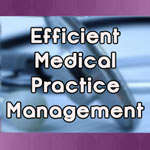Do you ever wonder how some medical practices have it all together while others are clearly out of control and unorganized? Well I have reviewed some of my notes on the various offices I have visited over the years and made a list of what has worked for the well for efficient medical practice management. I’m sure we can add to this list but it’s a good place to start!
Efficient Medical Practice Management Best Practices
• Gather all new patient information either before the first visit or on the day the patient is seen and verify insurance information.
• Verify all established patient information upon arrival and make necessary changes. Verify insurance information whether there is a change or not. Co-payments increase, authorization and referral rules change, as do payer plan benefits.
• Achieve a 90% collection rate for co-payments at the point of service.
• Complete all encounter information for the billing office on the same day the activity occurred. This allows faster turnaround of money and no problems with filing limit restrictions.
• Research, correct, and return erroneous charge tickets from the billing office within three days of receipt.
• Standardize each job function.
• Improving accuracy, timeliness, and productivity requires careful review of every job function, even if the activities appear unrelated to billing.
• Poor execution at the front desk can slow down the billing process and drive up costs.
• It is not how much you spend on your business process; it is how you structure and manage it.
• Create a check list for the appointment/registration secretary.
• Develop control prior to the first patient visit.
• Identify the patient’s type of insurance and have a matrix available at the front desk to quickly identify the practice’s participation in each plan.
• If referrals are required, this is the best time for the patient to be involved in their care. Ask the patient to contact the PCP and have a referral faxed or sent electronically.
• Understand 0, 10 and 90 day post-op surgical guidelines.
INSURANCE DENIAL TRENDS
• Track information:
• Registration errors
• Verification of coverage
• Incomplete information
• Referral problems
• Determine who is making the mistakes
• Establish who should have caught the errors
• Review with the employee the type of errors and how to do the job correctly
• Monitor monthly progress
• Practice should see a decrease in errors and increase in prompt payments
• Use information to evaluate employees’ performance
ACCOUNTS RECEIVABLE AND COLLECTIONS – BILLING DEPARTMENT
• File all charges within 24 hours of receipt.
• File in-patient claims within 24-48 hours of receiving discharge notification.
• Post all payments received on account within 24 hours of receipt.
• Maintain aged A/R at less than two times current collections.
• Maintain days in A/R at 45 days or less.
• Resolve patient inquiries within 5 days, preferably immediately on the telephone.
• Submit patient or insurance refunds within 3 days of request.
• Send out patient statements weekly or at month end.
• Keep accurate notes for all plans negotiated with patients and document collection efforts.
• Flag patient statements with collection message at 60 days.
• Send collection letter at 90 days and follow-up with a phone call.
• If no response, send delinquent statements to a collection agency.
Accountability for our actions is a basic standard. If everyone took responsibility for their job and tried to perfect it, office flow would soon follow leading to an office demonstrating stellar medical practice management. I guarantee it.
![[CCO] Certification Coaching Organization LLC [CCO] Certification Coaching Organization LLC](https://www.cco.us/wp-content/uploads/2015/05/CCO-Logo-2015-d3-500px.png)
